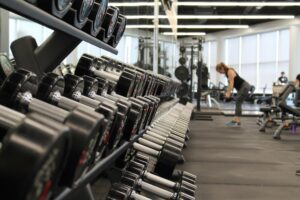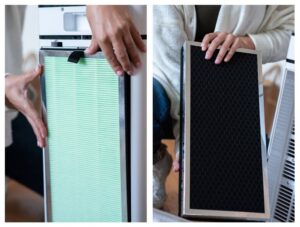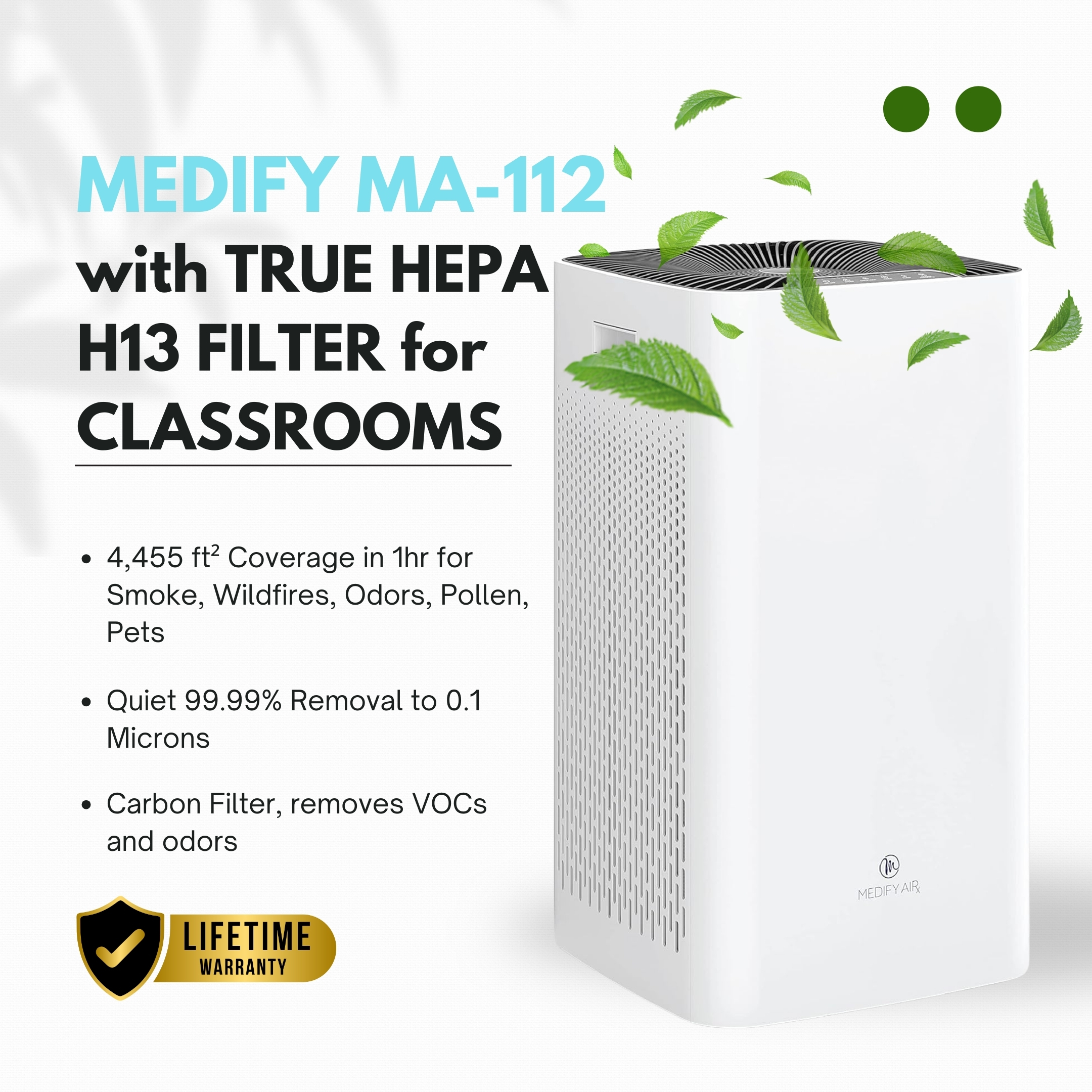How to Clean HEPA 13 or 14 Filters

Understanding the Fragility of HEPA 13 or 14 Filters: Why Cleaning Should Be Done with Caution
HEPA 13/14 filters are designed to capture up to 99.99% of particles as small as 0.1 microns, making them essential for maintaining high indoor air quality. However, the very structure that makes these filters so effective—an intricate web of microfibers—is also what makes them fragile. As a professional in indoor air quality, I strongly advise against vacuuming or washing these filters. Both of these actions can damage the microfibers, compromising the filter’s ability to capture fine particles. While some sources may suggest these methods as a way to extend the life of a HEPA filter, it’s important to understand that once the microfibers are broken, the filter’s efficiency is significantly reduced. Instead, it’s best to follow manufacturer recommendations, which typically suggest replacing the filter when it becomes clogged or reaches the end of its lifespan. Proper handling and timely replacement are key to ensuring that your HEPA 13/14 filter continues to perform at its highest capacity, keeping your indoor environment as clean and safe as possible.
The reason some manufacturers still have vacuuming as an option in their manuals is because these manuals were printed pre-Covid, pandemic times. These companies are just trying to make money and they are not worrying about CDC and FDA and world health recommendations. I’m not quite sure why Companies still are advising this, but in my professional opinion, it damages the filter!
HEPA Filter Maintenance: The Risks of Vacuuming and Washing
Maintaining HEPA 13/14 filters requires careful consideration to avoid damaging the delicate microfibers that make these filters so effective. As an expert in indoor air quality, IAQ Solutions & Consulting Inc. emphasizes the importance of avoiding both vacuuming and washing when it comes to HEPA 13/14 filters. Here’s why:
- Vacuuming Risks: The suction force of a vacuum can pull and stretch the microfibers within the filter, creating gaps in the material. These gaps reduce the filter’s ability to trap microscopic particles, effectively lowering its efficiency. Even with a gentle approach, vacuuming can compromise the structural integrity of the filter over time.
- Washing Hazards: Water and detergent can weaken the microfibers, causing them to lose their ability to trap particles. Additionally, drying a washed HEPA filter thoroughly is nearly impossible, and any residual moisture can lead to mold growth within the filter, further diminishing air quality.
- Reduced Filter Lifespan: Both vacuuming and washing can lead to premature wear and tear, reducing the filter’s lifespan and increasing the need for more frequent replacements. This not only raises costs but also increases the environmental impact.
To maintain the effectiveness of HEPA 13/14 filters, it’s essential to avoid these common cleaning mistakes. Instead, focus on regular monitoring and replace the filter according to the manufacturer’s guidelines. By doing so, you ensure that your filter continues to provide the highest level of protection against airborne contaminants.
The Professional's Guide: Safe Handling of HEPA Filters Without Damaging Microfibers
As a professional in indoor air quality, I can’t stress enough the importance of handling HEPA 13/14 filters with the utmost care to preserve their efficiency. The microfibers within these filters are designed to capture tiny particles, but they are also extremely delicate. Here’s how to safely manage your HEPA 13 or 14 filters without causing damage:
- Avoid Physical Cleaning: Never attempt to vacuum or wash your HEPA filters. These actions can stretch, break, or dislodge the microfibers, severely compromising the filter’s performance. Once these fibers are damaged, the filter’s ability to trap harmful particles diminishes significantly.
- Replace, Don’t Clean: Instead of cleaning, focus on regular monitoring and timely replacement of the filter. Most manufacturers provide specific guidelines on when a filter should be replaced based on usage and air quality. Adhering to these guidelines ensures optimal performance.
- Handle with Care: When replacing a HEPA filter, always handle it gently. Avoid bending or applying pressure to the filter material. Use gloves to prevent oils from your skin from contaminating the filter, which could also affect its performance.
- Proper Disposal: After replacing the filter, dispose of the old one according to local regulations. Used filters can contain harmful contaminants, so it’s important to handle disposal safely to avoid reintroducing pollutants into the environment.
By following these professional tips, you can ensure that your HEPA 13/14 filters continue to provide the highest level of protection for your indoor air quality, without risking damage to the delicate microfibers that make them so effective.
Preserving Your HEPA Filter's Integrity:
Cleaning Tips Without Compromising Quality
Maintaining the integrity of your HEPA 13/14 filter is crucial to ensuring that it continues to perform effectively. These filters are built with a delicate mesh of microfibers designed to capture even the smallest particles, but this also means they require careful handling. Here are key tips to preserve your filter’s quality without compromising its performance:
- Avoid Direct Cleaning Methods: Vacuuming or washing HEPA 13/14 filters may seem like a way to extend their life, but these actions can actually break down the microfibers. Once these fibers are damaged, the filter’s ability to trap particles is significantly reduced, leading to poorer air quality.
- Focus on Replacement Rather Than Cleaning: The best way to maintain your HEPA filter’s integrity is to replace it when it becomes clogged or reaches the end of its service life, as recommended by the manufacturer. This ensures that your filter continues to operate at peak efficiency.
- Inspect Regularly: Regularly check the filter for signs of wear or clogging. If you notice any reduction in airflow or an increase in dust levels, it might be time to replace the filter. A visual inspection can help you gauge when the filter needs to be changed.
- Store Spare Filters Properly: If you have spare filters, store them in a clean, dry place to prevent dust or moisture from compromising their effectiveness before they are even installed. Proper storage ensures that your replacement filters are in optimal condition when you need them.
- Use Manufacturer-Approved Filters: Always use filters that meet or exceed the specifications provided by the air purification unit’s manufacturer. This ensures compatibility and optimal performance, protecting your indoor air quality.
By following these guidelines, you can maintain the quality and effectiveness of your HEPA 13 or 14 filters, ensuring that they continue to protect your indoor environment without risking damage to the sensitive microfibers that make them so effective.
Get a Free Indoor Air Quality Consultation Today
Ensure a Healthier Environment for Your School or Office!
Related Posts:

Optimizing Indoor Air Quality in Gyms: Essential Tips for a Healthier Workout Environment
Optimizing Indoor Air Quality in Gyms: Essential Tips for a Healthier Workout Environment The Importance of Good Air Quality in

Never Vacuum A HEPA Filter
Never Vacuum A HEPA Filter The Risks of Cleaning a HEPA Filter Stephen Fontaine, an expert in indoor air quality,

Classrooms Are Running Out of Time to Improve Indoor Air Quality in 2024
Classrooms Are Running Out of Time to Improve Indoor Air Quality in 2024 In 2024, the urgency to address indoor
Expert's Advice on Why You Should Avoid Vacuuming and Washing HEPA Filters
HEPA 13/14 filters are a critical component in maintaining indoor air quality, but their effectiveness depends heavily on how they are maintained. As an expert in this field, I strongly advise against vacuuming or washing these filters, and here’s why:
-
Damage to Microfibers: The intricate microfibers within HEPA 13/14 filters are what allow them to capture up to 99.99% of airborne particles. Vacuuming these filters can pull and stretch the fibers, creating gaps that reduce the filter’s efficiency. Similarly, washing can weaken the fibers, leaving the filter unable to trap particles as effectively.
-
Reduced Filtration Efficiency: When the microfibers are damaged, the filter loses its ability to capture fine particles like dust, pollen, and even some bacteria and viruses. This not only diminishes air quality but also defeats the purpose of using a high-efficiency filter in the first place.
-
Risk of Contamination: Washing a HEPA filter introduces moisture, which can lead to mold growth within the filter if it’s not thoroughly dried—something that’s nearly impossible to achieve. This contamination can then be released into the air, worsening rather than improving indoor air quality.
-
Shortened Filter Lifespan: Vacuuming or washing HEPA filters accelerates their wear and tear, meaning you’ll need to replace them more frequently. This not only increases costs but also contributes to unnecessary waste.
-
Professional Recommendation: The safest and most effective way to maintain your HEPA 13/14 filter is to follow the manufacturer’s replacement guidelines. Regularly inspect the filter and replace it when necessary rather than attempting to clean it.
By avoiding these common cleaning methods, you protect the delicate microfibers in your HEPA filter, ensuring that it continues to provide maximum protection against airborne contaminants.
Proper Care for HEPA 13 or 14 Filters

HEPA 13/14 filters are engineered to provide exceptional air filtration by capturing tiny particles, including dust, allergens, and even some pathogens. However, their efficiency is largely dependent on the integrity of their delicate microfibers. To ensure these filters continue to perform at their best, it’s crucial to handle them with care. Here’s how you can protect your HEPA 13/14 filters from damage:
Handle with Precision: When installing or replacing your HEPA filter, do so gently. Avoid bending or squeezing the filter, as physical stress can damage the microfibers. Wearing gloves can also prevent oils from your hands from contaminating the filter.
Avoid Cleaning Methods: Both vacuuming and washing are highly discouraged. These actions can break, stretch, or weaken the microfibers, which are essential for trapping small particles. Instead of extending the life of the filter, cleaning often leads to reduced efficiency and a shorter lifespan.
Timely Replacement: Follow the manufacturer’s recommendations for filter replacement. HEPA 13/14 filters are designed to be replaced, not cleaned. Replacing the filter when it reaches its capacity ensures that your air purification system continues to function effectively.
Storage Precautions: Store spare filters in a clean, dry environment. Exposure to moisture or dust before use can compromise their effectiveness, so keep them sealed and protected until needed.
Regular Monitoring: Periodically check the filter for signs of clogging or damage. If you notice a decrease in airflow or an increase in indoor dust, it may be time to replace the filter.
By following these best practices, you can ensure that your HEPA 13/14 filters remain in optimal condition, providing the highest level of protection for your indoor environment. Proper care is key to maintaining the filter’s integrity and ensuring it continues to deliver clean, healthy air.
Got questions? Contact us or get free consultation.
Adherence to Guidelines from:
- World Health Organization
- CDC
- EPA
Expert in the field of IAQ
Our seasoned advisors provide trusted solutions to secure your family's or employees' health.
Each case is handled alone
Personalized approach to address your specific air quality needs effectively and efficiently.
Chat with an expert any time
Access our expert advice whenever you need it, ensuring continuous support for your air quality concerns.
Helped install 1.2 Million air purifiers
Proven track record of enhancing indoor environments with our comprehensive air purification solutions.







